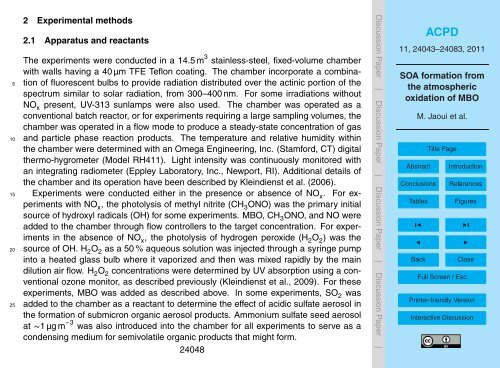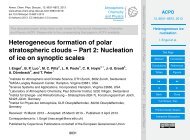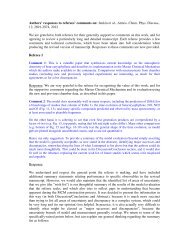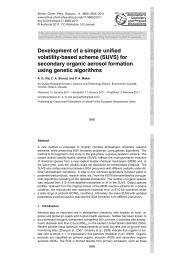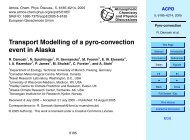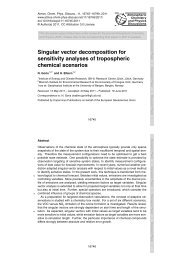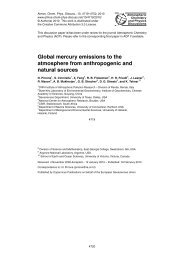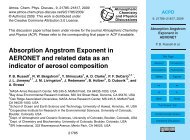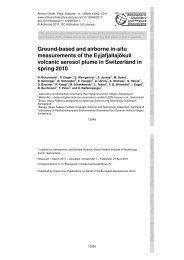SOA formation from the atmospheric oxidation of MBO - ACPD
SOA formation from the atmospheric oxidation of MBO - ACPD
SOA formation from the atmospheric oxidation of MBO - ACPD
Create successful ePaper yourself
Turn your PDF publications into a flip-book with our unique Google optimized e-Paper software.
5<br />
10<br />
15<br />
20<br />
25<br />
2 Experimental methods<br />
2.1 Apparatus and reactants<br />
The experiments were conducted in a 14.5 m 3 stainless-steel, fixed-volume chamber<br />
with walls having a 40 µm TFE Teflon coating. The chamber incorporate a combina-<br />
tion <strong>of</strong> fluorescent bulbs to provide radiation distributed over <strong>the</strong> actinic portion <strong>of</strong> <strong>the</strong><br />
spectrum similar to solar radiation, <strong>from</strong> 300–400 nm. For some irradiations without<br />
NO x present, UV-313 sunlamps were also used. The chamber was operated as a<br />
conventional batch reactor, or for experiments requiring a large sampling volumes, <strong>the</strong><br />
chamber was operated in a flow mode to produce a steady-state concentration <strong>of</strong> gas<br />
and particle phase reaction products. The temperature and relative humidity within<br />
<strong>the</strong> chamber were determined with an Omega Engineering, Inc. (Stamford, CT) digital<br />
<strong>the</strong>rmo-hygrometer (Model RH411). Light intensity was continuously monitored with<br />
an integrating radiometer (Eppley Laboratory, Inc., Newport, RI). Additional details <strong>of</strong><br />
<strong>the</strong> chamber and its operation have been described by Kleindienst et al. (2006).<br />
Experiments were conducted ei<strong>the</strong>r in <strong>the</strong> presence or absence <strong>of</strong> NO x. For ex-<br />
periments with NO x, <strong>the</strong> photolysis <strong>of</strong> methyl nitrite (CH 3ONO) was <strong>the</strong> primary initial<br />
source <strong>of</strong> hydroxyl radicals (OH) for some experiments. <strong>MBO</strong>, CH 3ONO, and NO were<br />
added to <strong>the</strong> chamber through flow controllers to <strong>the</strong> target concentration. For experiments<br />
in <strong>the</strong> absence <strong>of</strong> NO x, <strong>the</strong> photolysis <strong>of</strong> hydrogen peroxide (H 2O 2) was <strong>the</strong><br />
source <strong>of</strong> OH. H 2O 2 as a 50 % aqueous solution was injected through a syringe pump<br />
into a heated glass bulb where it vaporized and <strong>the</strong>n was mixed rapidly by <strong>the</strong> main<br />
dilution air flow. H 2O 2 concentrations were determined by UV absorption using a conventional<br />
ozone monitor, as described previously (Kleindienst et al., 2009). For <strong>the</strong>se<br />
experiments, <strong>MBO</strong> was added as described above. In some experiments, SO 2 was<br />
added to <strong>the</strong> chamber as a reactant to determine <strong>the</strong> effect <strong>of</strong> acidic sulfate aerosol in<br />
<strong>the</strong> <strong>formation</strong> <strong>of</strong> submicron organic aerosol products. Ammonium sulfate seed aerosol<br />
at ∼1 µg m −3 was also introduced into <strong>the</strong> chamber for all experiments to serve as a<br />
condensing medium for semivolatile organic products that might form.<br />
24048<br />
Discussion Paper | Discussion Paper | Discussion Paper | Discussion Paper |<br />
<strong>ACPD</strong><br />
11, 24043–24083, 2011<br />
<strong>SOA</strong> <strong>formation</strong> <strong>from</strong><br />
<strong>the</strong> <strong>atmospheric</strong><br />
<strong>oxidation</strong> <strong>of</strong> <strong>MBO</strong><br />
M. Jaoui et al.<br />
Title Page<br />
Abstract Introduction<br />
Conclusions References<br />
Tables Figures<br />
◭ ◮<br />
◭ ◮<br />
Back Close<br />
Full Screen / Esc<br />
Printer-friendly Version<br />
Interactive Discussion


